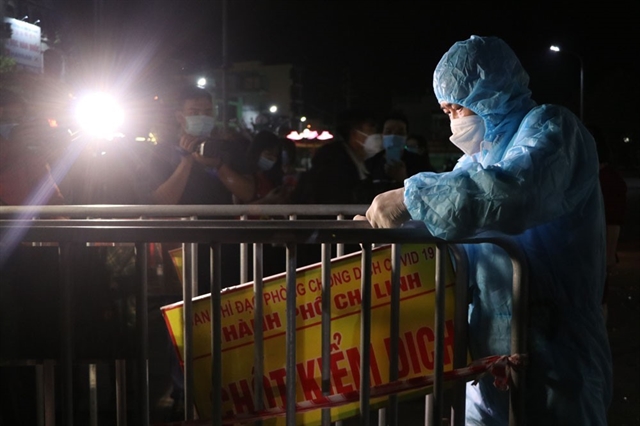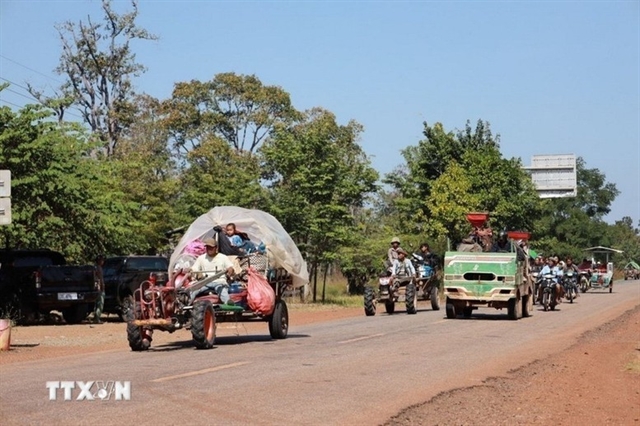 Society
Society

From midnight on March 3, the coronavirus lockdowns in Chí Linh City and Cẩm Giàng District in the northern province of Hải Dương were lifted and province-wide social distancing ended after 15 days.

|
| The lockdown in Chí Linh City of the northern province of Hải Dương was lifted at midnight on March 3 as the locality successfully controlled the COVID-19 outbreaks. — VNA/VNS Photo Mạnh Minh |
HẢI DƯƠNG — From midnight on March 3, the coronavirus lockdowns in Chí Linh City and Cẩm Giàng District in the northern province of Hải Dương were lifted and province-wide social distancing ended after 15 days.
On January 27, the first community COVID-19 case in Hải Dương Province’s Chí Linh City was detected – Patient 1,552 – a worker in close contact with a woman who tested positive for SARS-CoV-2 after arriving in Japan.
According to the National Steering Committee for COVID-19 Prevention and Control, Chí Linh City was the largest outbreak in the country since the pandemic began early last year with 383 confirmed cases out of 684 cases reported in Hải Dương Province.
The outbreak started at a company with more than 2,300 workers and then spread to the community, which caused difficulties in controlling the infections.
As the outbreak was gradually controlled, Hải Dương Province authorities decided to end the lockdowns and province-wide social distancing, entering a “new normal” phase with twin tasks of drastically fighting the coronavirus and taking action for socio-economic development.
At the moments when lockdown barriers were removed at Sao Đỏ Square in Chí Linh City, local officials, people working on the frontlines and residents expressed excitement and happiness.
Vice head of Bến Tăm Ward’s Police Vũ Văn Tú said that he worked at Sao Đỏ Square's COVID-19 checkpoint since January 27.
“As the city is no longer under lockdown, we are very happy because it proved that we beat COVID-19,” he said, adding that work and production could resume.
Doctor Nguyễn Thị Hằng from Chí Linh City Healthcare Centre’s Diseases Control Department said that like many people, she felt the lockdown-lifting moment was like New Year’s Eve when people usually think of a better beginning.
“For over 20 years working in the healthcare sector, the past month is the first time I worked under such high pressure. We usually skipped meals or ate during short breaks as many COVID-19 cases and their close contacts were reported,” Hằng said.
She added that her workload gradually fell over the last ten days.
Nguyễn Thành Nam, a resident in Chí Linh, said that after the lockdown, residents would still strictly follow preventive measures, avoid crowds and would try their best to contribute to the city and the whole province’s development.
Nam said that amid the pandemic, he understood and appreciated more about the care and support among people in Chí Linh, as well as of people across the country to those under lockdown.
Secretary of Hải Dương Province Party Committee Phạm Xuân Thăng applauded efforts made by authorities, health experts and people in fighting the pandemic, particularly contributions of people on the front lines.
Besides lifting the lockdown in Chí Linh City and Cẩm Giàng District and the end of province-wide social distancing, the Hải Dương Province People’s Committee on Tuesday decided to divide the localities in the province into two groups under different restrictions depending on the COVID-19 risks.
Until March 17, four high-risk localities, including Hải Dương City, Kinh Môn township, Cẩm Giàng District and Kim Thành, will be placed under the Government’s Directive 15, the highest level of social distancing first introduced in March last year when the country entered nationwide lockdown. The directive prescribes limiting large gatherings, meetings with over 20 people in-doors or 10 people outdoors, maintaining two metres distance between individuals in public places, non-essential services are shut down, public passenger transport is halted, and travel is heavily restricted.
The remaining eight localities in the province will follow the less restrictive Government’s Directive 19 on social distancing norms.
Hải Dương will continue to halt festivals, religious rituals, sporting events and other unimportant events that require large gatherings in public.
Associate Professor Trần Đắc Phu, former head of Health Ministry’s General Department of Preventive Medicine and now a senior consultant of the health ministry’s Public Health Emergency Operations Centre told chinhphu.vn that further testing and monitoring should be continued in high-risk areas to detect hidden outbreaks.
Social distancing measures should be implemented flexibly, for example, trade and production activities would be allowed if they could ensure the ability to trace new cases and conduct tests if needed, Phu said.
“It is necessary for Hải Dương Province to detect a possible risk of an outbreak in a certain area. The risk can be defined thanks to massive testing for areas with reported cases of fever or cough,” Phu said, adding that community-based COVID-19 prevention teams could help collect information.
Hải Dương now has about 11,000 such teams with the participation of about 25,000 members.
Then, authorities need to assess the connection between the other areas and the areas where outbreaks happened.
Each locality in the province should also review their preventive measures and strictly follow the Health Ministry’s '5K' message as the pandemic was still developing worldwide. Provinces with industrial zones like Hải Dương were always more vulnerable to disease risks. — VNS




